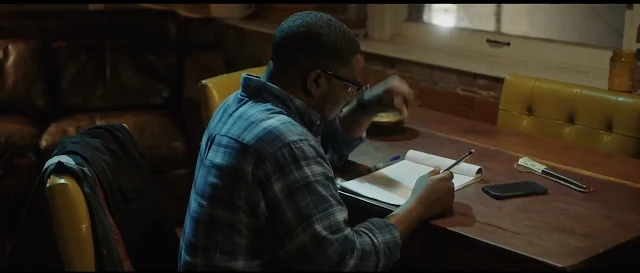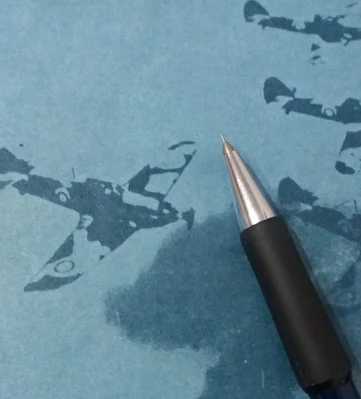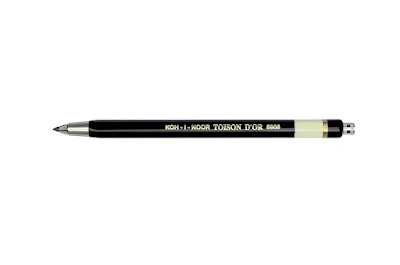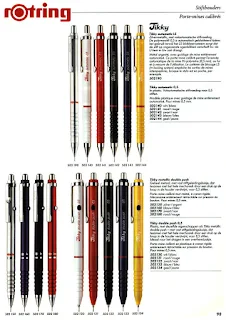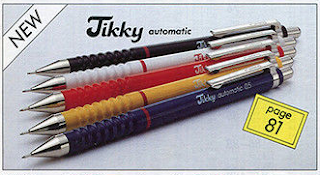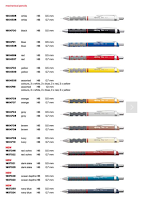I am a long Rotring Tikky user and today I will share with you the beloved mechanical pencil.
I got my first Rotring mechanical pencil in middle school. If I am not mistaking it was a yellow second generation of Rotring Tikky. Unfortunately, I lost it sometime during high school. At some point, I had a red second generation Rotring Tikky but I can't remember it's faith. At the moment I have a black second generation Rotring Tikky 0.7 that I got in high school and used throughout the university, 2 Rotring Tikky's third generation one 0.5 and one 0.7 mm. One of my big regrets is that I do not have a Tikky Special first generation.
I only owned and used Rotring during the school years. The exception to this was my first mechanical pencil, a plastic no-name followed by a Bic. Both of them I had in the early years of school when I think my parents didn't trust me with a precision instrument :)
Both of my parents are engineers and both were using Rotring for many years as it was pretty much the standard in the industry. Why everyone was using them is pretty clear. They are affordable, of good quality, a precise instrument that will last a very long time, and they are readily available. They come in all sizes 0.35 mm, 0.5 mm, 0.7 mm, and 1.0 mm. And also, I do not think that the market back then didn't have such a plethora of mechanical pencils to choose from.
At least here (Romania), if you will go into a stationary shop it is almost certain they have Rotring Tikky mechanical pencils. In the last years, the Faber Castell has been a lot more aggressive and is starting to dominate the shelves of the stores. So maybe the new generations will grow with Faber Castell instead of the Tikky.
In the next lines, I will try sharing with you the information I have managed to gather about the Rotring Tikky mechanical pencils starting from the first generation up to the last.
The history behind the Rotring Tikky mechanical and the information about the models and their characteristics.
In 1979 the Rotring Tikky mechanical pencil debuts
In 1997 the second generation of Tikky hits the market
In 2008 the third generation of Tikky was available to the customers.
A nice graphical presentation of the Rotring history can be found on their site at the following link:
http://www.rotring.com/en/heritage
Rotring Tikky I
The first generation of Rotring Tikky was produced in West Germany and in Germany after 1989. It featured a metal drafting fixed point a slim body with a waved grip section. The barrel was made out of plastic or metal and it was available in different colors. It had a sturdy clip which was made out of metal and on it was stamped "Rotring" and "W. Germany" until 1989 and with "Rotring" and "Germany" after. The cap was metallic and was hiding the eraser. Only present in the Tikky Special, the eraser also had a pin in it to unclog the pencil if the lead would jam in it. The next models do not have this feature anymore. The mechanism inside was made out of brass and could be taken out of the pencil.
Rotring came out with several models of the Tikky right at the beginning, and there were a few variants between labeling them. For example, not all Rotring Tikky first generation came with a red ring and others had the name rOtring written in red instead of the red ring. Some of the pencils featured an endcap that had on the tip of it standard color coding for the size of the lead. The barrel came in all sorts of colors, even crazy psychedelic paints.
With the first generation, Rotring seemed to use the size 0.3 mm and 0.9 mm instead of 0.35 mm and 1.0 mm nowadays.
Rotring introduced the Trio Pen which later became the Tikky 3 in 1. The first reference I found about the Trio pen was in a 1990 German product catalog but I think the model appeared sooner. Also alongside with the first Tikky mechanical pencil Rotring brought to the market the Tikky ballpoint.
The birth of one of the most beloved mechanical pencils took place 10 years before the launch of the Rotring 500/600 (1989) Series and 14 years before Rotring 800 (1993).
The Tikky I inspired Rotring to transfer the good features to the metal series 400 of mechanical pencils, pens, and fountain pens. This line was later marketed as Esprit.
The versions of the Tikky were:
Tikky Special
rotring T (sliding sleeve from 5 mm to 3.5 mm in early models, fixed sleeve later on)
rotring TS slide (half sliding sleeve - I think is the successor of the rotring T)
rotring Fineliner F or just
rotring F (fixed 4 mm sleeve)
Tikky Automatic and
rotring Automatic LS (auto advance of lead, LS stands for locking system)
Tikky Double Push (plastic and metallic versions - both these versions had a secondary push button on the barrel)
rotring S (plastic and metallic versions, 3 mm to 0 mm sliding sleeve)
The differences between the models:
Tikky Special - Plastic design with a fixed sleeve. It came in 0.3 mm, 0.5 mm, 0.7 mm. Some of the Tikky Special did not have a red ring while others had. There was a white version of the Tikky special which had all sizes available 0.3 mm 0.5 mm 0.7 mm 0.9 mm. The writing and the ring on these were color-coded to the lead size.
yellow for 0.3 mm
brown for 0.5 mm
blue for 0.7 mm
orange for 0.9 mm
rOtring T - "Mechanical pencil with fine lead T for technical drawings, before ink lining
Through the technical precision of the pencil rOtring T a long existing problem has been answered: making a neat drawing using a ruler and a template. The tubular lead guide retracts from 5 mm to 3.5 mm (the thickness of a ruler). rotring T is delivered in 3 lead sizes 0.3 mm, 0.5 mm, 0.7 mm, each model comes with HB polymer lead. The pencils container comes with 6 leads for backup."
The main feature of the T model is the partially retractable sleeve which was I think a safety mechanism for when using a ruler and also it gave the possibility to have maybe more control. The end cap had a size color coding.
The 1.5 mm retracting sleeve feature was abandoned as in the Rotring 1990 catalog the model rOtring T is marketed as a fixed sleeve.
rOtring TS slide - in the Rotring 1990 catalog, the rOtring TS slide is marketed as a half sliding sleeve. This I think is the successor of the model T which at this point became a fixed sleeve.
rOtring F - "Mechanical pencil with fine lead F for writing and sketching.
This pencil is equipped with a rigid tubular lead guide with a length of 4 mm which avoids lead brakes and offers a precision execution when using a ruler. rotring F is equipped with polymer lead size 0.5 mm HB. The pencils container comes with 3 leads for backup."
So the F model was available only in 0.5 mm.
Tikky Automatic LS - Metall mechanical pencil with fully automatic lead feed, comes in 0.5 mm. The lead automatically advances during use while the "LS" locking system prevents undesirable lead feed (when carrying in a pocket for example)
Tikky Automatic - Plastic version of the previous model, with fully automatic lead feed, comes in 0.5 mm. Does not feature the locking system. This model of the rOtring Tikky was first introduced in the 1988 Catalog
Tikky Double Push - Comes in a plastic and a metal version. It features a fixed sleeve protector and fully retractable feed mechanism. The main feature is a secondary side button to advance the lead. The metallic version of the double push sometime later changed series and became the Rotring 400 Esprit. Later the 400 was discarded and the line name remained Esprit. Rotring offered in the Esprit range fountain pen, ballpoint, mechanical pencil. The Esprit range offered a duo-pen (blue ballpoint and a 0.5 mechanical pencil in one body). There was a mini rotring Esprit line as well that included the mechanical pencil and the ballpoint. The Esprit mechanical pencil also came with a "telescopic" mechanism (available for the mini and the full version length)
The pencil was only available in 0.5 and 0.7 mm lead.
rOtring S - "Mechanical pencil with fine lead S for writing and neat sketching.
The tubular lead guide retracts with 3 mm in sync with the use of the lead. This way an optimal efficiency of the lead as well as a maximum safety against lead snaps. rotring S is equipped with polymer lead 0.5 mm, hardness HB. The pencil's container comes with 6 leads for backup."
So the S model features a 3 mm sliding sleeve. The body of the pencil comes in plastic or metal. The end cap had a size color coding.
The yellowish color is "safari green"
(click on the images to enlarge)
 |
| rOtring T / rOtring F / rOtring S (1980) Rotring product catalog (Romania) |
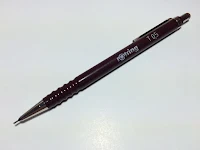 | rOtring T
|
| 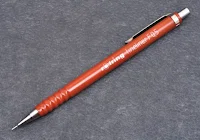 |
| rOtring Fineliner F |
|
 |
| rOtring clip W.Germany before 89 |
|
|
|
|
 Tikky Special Tikky Special |
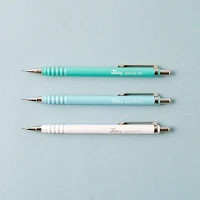 | Tikky Special without red ring
|
|
Metallic Double Push Tikky
|
 | rOtring F Fineliner
|
|
|
|
|
|
 rOtring Special and box rOtring Special and box
|
 | rOtring TS slide
|
|
 |
| rOtring T brass mechanism |
|
 | | Tikky Special multiple colors |
|
Tikky Automatic
|
rOtring Special without red ring
|
 Metallic Double Push Tikky Metallic Double Push Tikky
|
|
|
Rotring Tikky II
The Second Tikky suffered a few changes. First, it gained a little bit of weight. It became a little bit fatter. Second, the clip style changed. It is a less secure one, but esthetically looks nice. The clip is not stamped with anything which is a shame. Where the clip meets the barrel it is cast in plastic with a very small font "Made in Germany". The rest of the writing on the pencil is paint. The barrel is plastic. The Tikky II weighs 10 grams.
The Rotring Tikky II came in 2 variants
rOtring Tikky II - which had markings on the pencil "rOtring Tikky II 0.5" or "rOtring T 0.5". This is the most common version of the Tikky 2. It came in a variety of colors including metallic and transparent barrels.
The metallic colors were part of the INLINE series and offered options like pearl blue, pearl violet, pearl red, pearl yellow.
The branding rOtring T was present only on the burgundy version of the Tikky II and included ISO color coding. The rOtring Tikky II came with and without color coding on the barrel.
rOtring Tikky SC - features a retractable tip and a rubberized grip. This one is less common and less accessible. The SC stands for Super Comfort.
(click on the images to enlarge)
|
|
|
|
|
 |
| rOtring T branding |
|
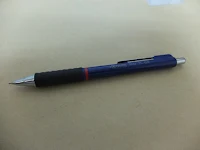 |
| rOtring Tikky SC |
|
 |
| rOtring Tikky SC |
|
|
|
 |
| Made in Germany marking |
|
 |
| rOtring Tikky II 4C Tone 2007 Back to school Catalog |
|
 |
| rOtring Catalog 2004 Pens and Pencils, IN LINE pearl colors (metallic) |
|
|
|
|
Rotring Tikky III
The third generation named just Rotring Tikky is a reincarnation of the Tikky line after Rotring was bought by Standford. The pencil is also sold under the name "Papermate Tikky by Rotring" or just "Papermate Precision" version which does lack the traditional red ring.
The third generation of Tikky debut in 2008 and is produced in China while the previous two were made in Germany. The biggest difference to the previous version is a partial rubberized grip (although the rOtring Tikky II SC featured a rubber grip, it had a different form), and the end of the barrel is triangular, making it less likely to roll off the table. The barrel is made out of ABS and the front cap is made out of stainless steel which has a constant slope as opposed to previous versions which had a step. The quality of this part I think is inferior compared to the quality found on Tikky II.
The clip style changed and now offers a look closer to the original Tikky clip, and it has stamped the rOtring name on it. The writing on the barrel changed to simply "rOtring Tikky 0.5", instead of numbering the generation with III. The cap has a hole at the top as a safety feature for children. It weighs 12 grams, 2 grams more than the second version and measures 142 mm in length from tip to cap and it has a diameter of 9 mm around the grip area.
Currently, the Rotring Tikky is offered in 23 colors, the latest colors included in the range are neon. Only the black and the burgundy models come with size color coding on the barrel and come in all lead sizes from 0.35 mm to 1.0 mm. They are marketed as Tikky professional mechanical pencils.
The classic Rotring colors like blue standard, white standard, yellow standard, red standard, black (version without the color coding) come in 0.5 mm, 0.7 mm, and 1.0 mm while the rest of the bunch come only in 0.5 or 0.7 mm.
(click on the images to enlarge)
Updates:
Aprl 30, 2019 - Additional information about Tikky I, and Esprit
March 7, 2019 - Credits added
October 9, 2018 - Small updates, no extra information about Tikky line added
25/3/2018 - Tikky Automatic debut in 1998 (pic),
more information on Tikky Double Push metallic which became Rotring 400 Esprit, and then just Esprit (pictures)
Pictures of the pearl (metallic) Tikky II In Line added
Resources, extra information
Rotring catalogs
Rotring website
Pictures from sales site's like eBay and others alike
Particle Navigator
Mechanical Pencil Museum
Golyostoll (in Hungarian - if you need help google translate)
Pretty Splendid (beautiful Rotring Tikky 1 & 2 collection)
Kelvin Pang
A very nice history about Rotring products can be found at Unofficial Rotring
Contributions to the information presented are welcomed.



